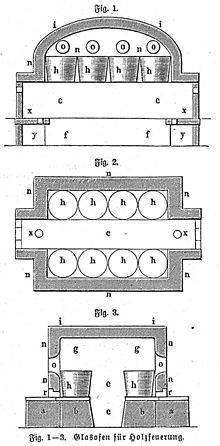Harbor furnace
A harbor furnace is a furnace that is used in glassworks to melt glass . The name is derived from the vessels of the harbors ( crucibles ) in which the molten glass is located, and thus differs from day tubs . Harbor furnaces are used to produce small quantities of glass, such as art glass, colored glass, tumbler or special glasses. Since a furnace contains several ports, different glasses can be melted at the same time.
business
In contrast to the tank furnace , which works continuously, port furnaces are operated discontinuously in day shifts. The batch is placed in the port (charging) and melted down at a high temperature (rush melting), followed by refining (bright melting), with the furnace being brought to maximum temperature. In the subsequent standing phase, the glass cools down to the lower processing temperature and is finally removed for processing with a glassmaker's pipe or by pouring it out.
Due to the inefficient use of energy and the laborious handling of the ports, port furnaces are increasingly being replaced by miniature tank furnaces.
construction
A distinction is made between cell ovens with 1 or 2 ports (studio glass ovens), round ovens with up to 7 ports and deckle ovens with up to 16 ports. They are mostly fired with natural gas ; small ovens can also be electrically heated.
Covered ports are also used for the production of lead glass , especially in France and England .
port

The glass melting vessels of the ports, mostly made of fireclay or refractory clay , have a diameter of up to one meter and heights of 0.3 to 1 meter. You stand in a heated, fire-proof walled furnace room, which has a furnace door for each port, through which glass is removed for processing, as well as a port door through which the port can be replaced. The ports wear out relatively quickly due to the high, fluctuating thermal loads - the typical service life is 50–100 melts, corresponding to 10 weeks to a year depending on use.
If the port has become too thin after this time, the process of port change begins. With all the preparations, this takes up to 7 days. You start with setting the new port, that is, driving it into a special port tempering furnace.
This tempering furnace differs from the normal melting furnace mainly in that the flame never touches the port directly, but indirectly heats the port through a system of pipes and shafts. This is essential for the annealing , which must be carried out very carefully, slowly and precisely. This slow heating up to the final temperature of 1200 ° C is carried out at different rates of increase from 3 ° C / h to 15 ° C / h in 5-8 days.
Then the heated port is driven through the port gate into the actual glass melting furnace by means of a metal cart. It is important that all doors and windows of the glassworks are closed during this delicate process, otherwise even the slightest gust of wind that touches the port could cause irreparable damage to the port.
If the port is in the furnace, the port gate is closed again and the first melt in the port begins, the so-called maiden melt. This consists only of old shards, since the deposit of the mixture would attack the still unglazed harbor. This melt usually takes 12 hours. Part of the liquid glass from the virgin melt is scooped over the edge of the harbor. The resulting glaze protects the harbor from the attack of the mixture.
History of the ports
From the early days of glass production, vessels for melting were found in Egypt. They were made of Nile mud and had only small dimensions with a diameter of about 15 cm and a height of about 10 cm. In Roman times, high bowls or pots with a recessed rim in the manner of cooking vessels were used as ports, which were sufficiently fireproof for the Roman melting furnaces that worked for the Roman lime-soda glass below 1100 degrees. In the Middle Ages , more refractory glass melting vessels were required for the production of wood ash glass, which required melting temperatures of over 1200 degrees. In northern Germany , clays from the pottery and glassmaker's village Großalmerode were used from the 16th century onwards, which were characterized by their fire resistance.
literature
- Hans-Georg Stephan : Glass melting vessels. Basics of development from the beginnings in the ancient Orient to modern times , in: Glassworks in conversation. Reports and materials from the 2nd International Symposium on Archaeological Research into Medieval and Early Modern Glassworks in Europe , Ed .: Peter Steppuhn on behalf of the Kulturkreis Glashütten ev, Lübeck, 2003, ISBN 3-7950-0795-X .

